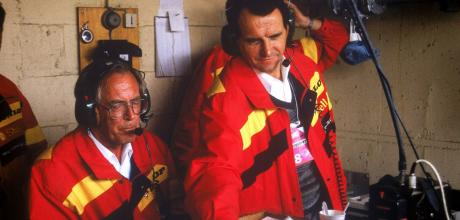Porsche chassis specialist, Helmut Flegl, reaches his eightieth birthday
Born in Hungary on the 7th April 1942, Helmut Flegl was responsible, among other things, for the success of the 917. He joined Porsche in 1966. Just three years later, the graduate engineer, who was only twenty-seven years old, worked with Hans Mezger and Peter Falk to turn the seemingly untameable 917 into a winner.
Ferdinand Piëch, then head of Porsche’s motorsport development division, wanted to beat all of the Stuttgart brand’s rivals in every available competition with the company’s new sports prototype. Outright victory at Le Mans was chief in his thoughts. After initial tests, however, even the most seasoned racing drivers on Porsche’s roster considered the 917 undrivable. “For my team, the biggest challenge was to reconcile the potential of this car with the needs of the drivers,” Flegl recalls.
HE PUSHED PORSCHE’S AMBITION TO WIN THE INDIANAPOLIS 500 WITH THE 2708 PROJECT
The 917 project was top priority at Porsche and was driven forward with absolute commitment. In the summer of 1969, factory drivers, Jo Siffert and Kurt Ahrens, used the flat-twelve-powered Porsche to win the 1000-kilometre of Zeltweg, but Piëch demanded overall victory in the International Championship for Makes and, of course, an outright win at Le Mans. He instructed Flegl and his team to optimise the 917’s handling and to schedule many test drives. Flegl will never forget one of these tests: on 7th April 1970, the occasion of his twenty-eighth birthday, Ahrens tested a modified 917 long-tail on the sealed-off Ehra-Lessien test site under Flegl’s instruction. Unexpectedly, a strong gust of wind caused the car to lose control and be torn in two against a guard rail. Thankfully, Ahrens survived this nasty accident with only minor bruising. After further chassis fettling, the 917 would go on to win at Circuit de la Sarthe just nine weeks later.
Flegl and his Weissach engineering colleagues, Hans Mezger and Valentin Schäffer, also had reason to celebrate in 1971, when Jackie Oliver took the wheel of a 917 long-tail on the second day of testing for the 24 Hours of Le Mans. Before the Briton got going, Flegl cautioned him. “We’re not quite sure about aerodynamic stability on the straights beyond a speed of 300km/h.” Six trouble-free laps later, Flegl ordered only marginal changes. To attain even more downforce, for example, he had the wheel arch vent slots on the front wings moved further forward. “Drive five laps at maximum speed,” was his order.
With a stopped time of 3:13.60 minutes, Oliver’s performance went down in the history books as the first Le Mans lap with an average speed of more than 250 km/h (exactly 250.457 km/h was calculated, although as a test drive, it was not officially recognised). As a consequence of Flegl’s changes, Porsche was able to repeat its overall victory with the 917 at Le Mans. In 1972, the 917/10 Spyder conquered the North American CanAm racing series thanks to important input from Flegl, leading the car to be recognised as the most powerful Porsche racing machine assembled. In 1973, he further lengthened the wheelbase of the 917/30 to improve its stability. He also worked successfully on the car’s aerodynamics, which provided necessary downforce for enormous power closing in on 1,100bhp.
Later, Flegl put the 936 on wheels, then took over management of 928 development. In 1978, he returned to the Weissach racing department and continued his work on the 936. A decade later, he pushed Porsche’s ambition to win the Indianapolis 500 with the ill-fated 2708 project. Flegl reached the end of his career in 2003. After thirty-seven years with Porsche, most recently as head of the Research and Advance Engineering department in Weissach, he decided to take early retirement. He has lived in Leonberg ever since and remains in close contact with Porsche.


